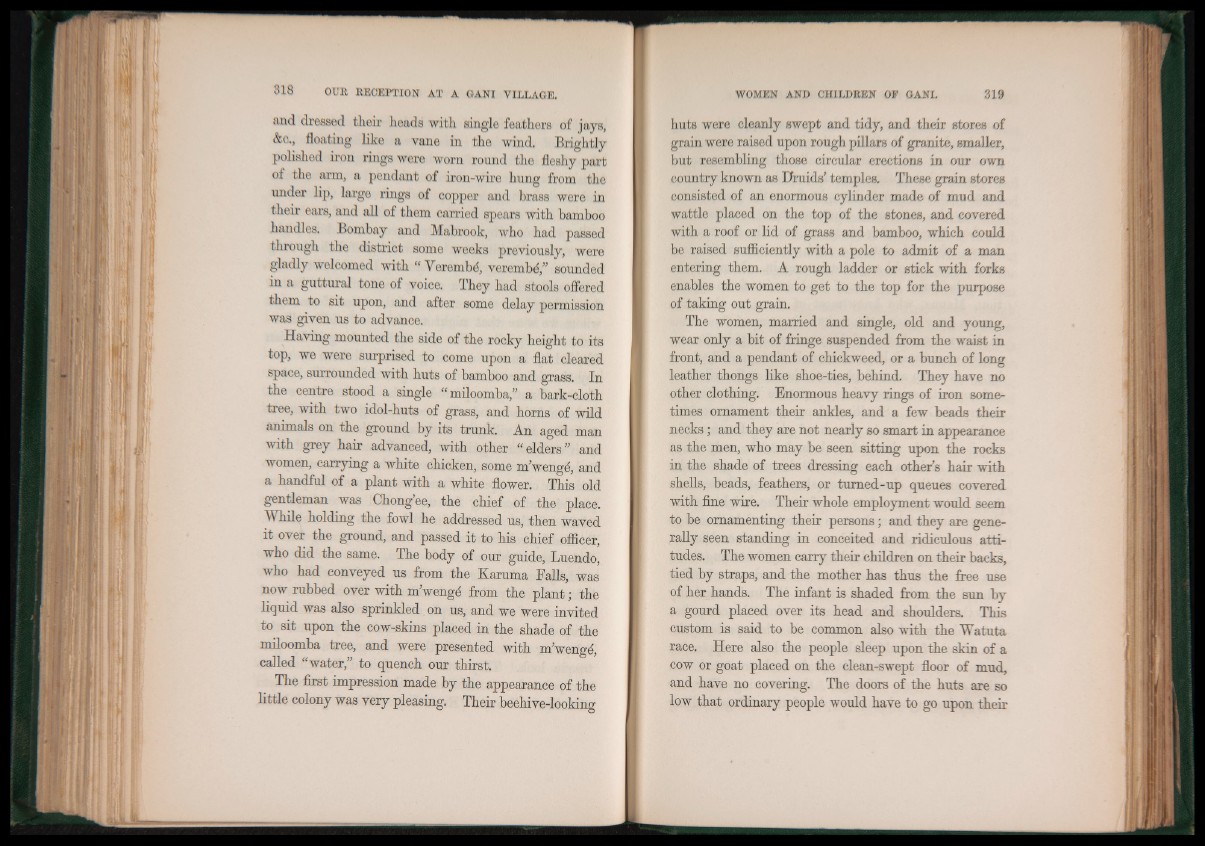
and dressed their heads with single feathers of jays,
&c., floating like a vane in the wind. Brightly
polished iron rings were worn round the fleshy part
of the arm, a pendant of iron-wire hung from the
under lip, large rings of copper and brass were in
their ears, and all of them carried spears with bamboo
handles. Bombay and Mabrook, who had passed
through the district some weeks previously, were
gladly welcomed with “ Veremb<$, verembd,” sounded
in a guttural tone of voice. They had stools offered
them to sit upon, and after some delay permission
was given us to advance.
Having mounted the side of the rocky height to its
top, we were surprised to come upon a flat cleared
space, surrounded with huts of bamboo and grass. In
the centre stood a single “miloomba,” a bark-cloth
tree, with two idol-huts of grass, and horns of wild
animals on the ground by its trunk. An aged man
with grey hair advanced, with other “ elders” and
women, carrying a white chicken, some m’wengd, and
a handful of a plant with a white flower. This old
gentleman was Chong’ee, the chief of the place.
While holding the fowl he addressed us, then waved
it over the ground, and passed it to his chief officer,
who did the same. The body of our guide, Luendo'
who had conveyed us from the Karuma Falls, was
now rubbed over with m’wenge from the plant; the
liquid was also sprinkled on us, and we were invited
to sit upon the cow-skins placed in the shade of the
miloomba tree, and were presented with m'wengd,
called “water,” to quench our thirst.
The first impression made by the appearance of the
little colony was very pleasing. Their beehive-looking
huts were cleanly swept and tidy, and their stores of
grain were raised upon rough pillars of granite, smaller,
but resembling those circular erections in our own
country known as Druids’ temples. These grain stores
consisted of an enormous cylinder made of mud and
wattle placed on the top of the stones, and covered
with a roof or lid of grass and bamboo, which could
be raised sufficiently with a pole to admit of a man
entering them. A rough ladder or stick with forks
enables the women to get to the top for the purpose
of taking out grain.
The women, married and single, old and young,
wear only a bit of fringe suspended from the waist in
front, and a pendant of chickweed, or a bunch of long
leather thongs like shoe-ties, behind. They have no
other clothing. Enormous heavy rings of iron sometimes
ornament their ankles, and a few beads their
necks; and they are not nearly so smart in appearance
as the men, who may be seen sitting upon the rocks
in the shade of trees dressing each other’s hair with
shells, beads, feathers, or tumed-up queues covered
with fine wire. Their whole employment would seem
to be ornamenting their persons; and they are generally
seen standing in conceited and ridiculous attitudes.
The women carry their children on their backs,
tied by straps, and the mother has thus the free use
of her hands. The infant is shaded from the sun by
a gourd placed over its head and shoulders. This
custom is said to be common also with the Watuta
race. Here also the people sleep upon the skin of a
cow or goat placed on the clean-swept floor of mud,
and have no covering. The doors of the huts are so
low that ordinary people would have to go upon their